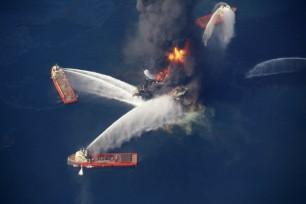BP abandoned well-capping plan with no explanation
 A Transocean engineer testified Tuesday that BP never explained its decision not to deploy a well-capping method his team had developed in 2010 to respond to the worst offshore oil spill in American history.
A Transocean engineer testified Tuesday that BP never explained its decision not to deploy a well-capping method his team had developed in 2010 to respond to the worst offshore oil spill in American history.Speaking from the witness stand in federal court during the high-stakes second phase of BP’s civil trial, the engineer said he was surprised when BP chose another route to attempt to curb the out-of-control flow of oil from BP’s Macondo well in the Gulf of Mexico. It was a sudden turnaround after days of steady progress.
“We were so close” to being mechanically ready to deploy the team’s well-capping method, Turlak said. The plan would have placed a blowout preventer on another blowout preventer, which Turlak said he regarded as a safe method. His team, composed of specialists from BP, Transocean and other contractors, had not encountered any problems it could not handle, he said.
During a cross examination, he said the method could not have been utilized before early June, after BP in late May tried its other method, “top kill,” which failed to stem the well’s flow.
Turlak told Paul Collier, an attorney for BP, that when he was on the team, he did not have any meetings with government experts who were working on capping solutions at the time, and did not know who on BP’s end was making decisions about capping methods. Turlak also did not have all the information about risks being assessed by other groups, he told Collier.
On Monday, the opening day of the civil trial’s second phase, attorneys for spill victims, U.S. officials and BP contractors argued the British oil giant used another source control procedure, known as “top kill”, to conceal that it knew the rate of oil flowing out of the blown out Macondo well was much higher than it said publicly.
Pointing to internal documents and emails, the plaintiffs’ attorneys said the company knew top kill would fail if the flow rate was higher than 15,000 barrels per day. The decision to proceed with the method delayed capping the well by several weeks, exacerbating the oil spill’s damage in the Gulf, the attorneys said.
The plaintiffs’ argument “defies common sense,” and that BP determined top kill was a low-risk, high-reward method, Mike Brock, an attorney for BP, had said on Monday.
The civil trial’s second phase centers on the company’s preparation for controlling the gusher and how much oil reached the Gulf of Mexico. Part of the phase will examine potential fines BP will have to pay under the Clean Water Act, which could balloon to $18.1 billion under government estimates of spilled hydrocarbons.
The law says fines could be between $1,100 to $4,300 per barrel, depending on whether the court rules the company was negligent or grossly negligent. The court also could set the fines lower than those levels.
A severe penalty could batter BP’s credit quality if the court finds the company was grossly negligent, Moody’s Investors Service said Tuesday. BP already has paid out $42 billion in costs related to the blow out.
“BP can tolerate about $40 billion in penalties, after taxes,” said Francois Lauras, vice president and senior credit officer at Moody’s. “A ruling in line with the company’s current $3.5 billion position would leave some headroom to absorb other charges,” including settlement costs from payouts to economic loss claimants.
In a video deposition shown at court Tuesday, a Halliburton employee said after BP deployed the “kill shot,” he learned that the company did not believe the method would work with a flow rate of more than 15,000 barrels of oil per day.
“I’m pretty angry,” said Richard Vargo, a cementing manager for Halliburton in the Gulf region. “We knew we had done work that identified the flow rate as being” 30,000 barrels per day.
You can return to the main Market News page, or press the Back button on your browser.

